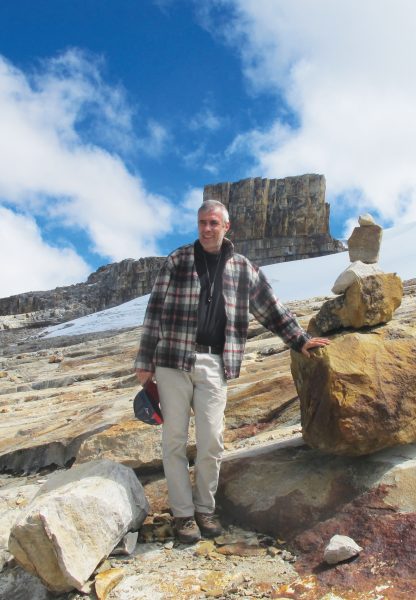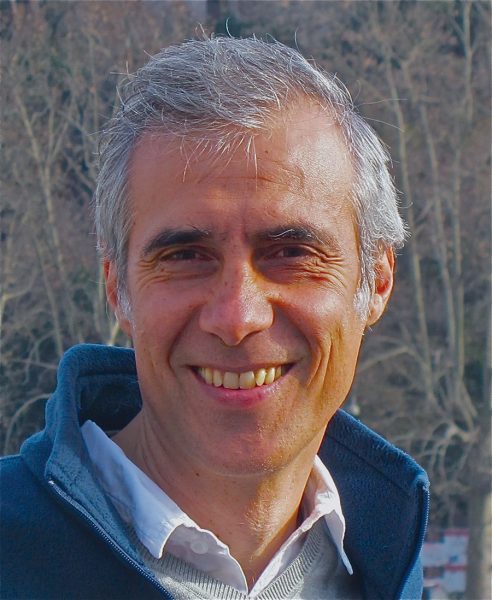Claudio Faccenna
November 21, 2019
Claudio Faccenna, the Jackson School’s newest structural geology professor, has spent his career studying mountain ranges from across the world. His research has taken him from the Apennines of Italy — the locale that first piqued his interest in geology as a child — to the Andes of Colombia and the Highlands of Ethiopia, among other places.
Spending time in the field is an essential part of his research, Faccenna said.
“In the field, you get ideas, you are inspired,” he said. Now at the Jackson School, one of his ongoing research projects involves bringing the mountains to him, leveraging the expertise and equipment at the school to make a mountain range in a box.
Faccenna has long combined intensive field study with experimental models that attempt to re-create geological processes in miniature. For example, some of his past research includes simulating tectonic-mantle interactions around trenches using a mixture of silicone putty, honey and crystallized honey enclosed in a tank. But he said that the Jackson School’s morphodynamics lab has the ability
and experience to take his modeling experiments further. He is now working with the lab to build a model that can account for all aspects of the mountain building process —from the deformation of the Earth’s mantle to the stripping away of sediments by raindrops.
“This will be a unique device, a completely original model that’s never been done because we need big expertise from different people working together and a huge space,” said Faccenna, who holds the John F. and Carolyn C. Bookout Endowed Chair in Structural Geology.
In the age of supercomputing and big data, constructing a mountain out of household materials can seem quaint. But even the most state-of-the-art super-computers can run into roadblocks trying to realistically model the complex and intertwined processes that build and shape mountains over time, Faccenna said. In fact, he said he thinks the difficulty in theoretically and computationally capturing the relationship between deep mantle processes and surface ones has kept research on what is an interrelated system in its own distinct silos. Laboratory experiments can help bridge that divide, he said.
“The geosciences is kind of split into people who are interested in the deep mantle and people who are interested in the shallow surface deformation, but we’ve all realized that’s just because of the difficulty to couple this process,” Faccenna said. “In the laboratory, it’s a bit easier. And this brings the community together to really interact.”
What computers can’t do, the morphodynamics lab can. Located in a large warehouse at the J.J. Pickle Research Campus, research engineers in the lab specialize in creating miniature geologic environments. That encompasses building the containers where experiments are run and helping select materials that can serve as realistic stand-ins for geologic phenomena that usually happen in nature at much larger and slower scales. For example, the lab’s staff has found that ground walnut shells are great for studying how river deltas shape landscapes, with the shells packing together to form escarpments while still being able to be swept along in the river currents — just like real sediments.
Faccenna said that seeing the lab and talking with its manager James Buttles, a research engineering scientist with 18 years of experience building geological models, cinched the deal to join the Jackson School when he was interviewing for the Bookout Chair position.
“I had the idea [for the mountain model] and said, ‘this is crazy,’” Faccenna said. “But look at this. This is the place where you can do it.”
A big Plexiglas box, 4 meters long by 4 meters wide by 2 meters high, has been set aside for the work on the laboratory’s floor. It’s currently filled with water and holds a smaller tank for studying how sinuous channels transport sediment and carve landscapes. But Buttles said that, in short order, the river environment will be traded for mountain-building ingredients. And although creating a mountain model that combines both deep earth and surface processes is very ambitious, he’s game to make it happen.
“There’s not a thought in my mind that we can’t do it,” Buttles said. “We’ll find a way to move forward.”

Faccenna considers the integrative mountain model as the next step in a scientific career that’s prioritized a systems approach to studying structural geology, always keeping in mind the interplay between the Earth’s different layers. He is a member of the Academia Europaea and a fellow of the American Geophysical Union, with his work leading to important insights on the formation of the Mediterranean during the past 35 million years and the connection between different tectonic processes and the resulting geologic formations. And as the editor-in-chief of the journal Geochemistry, Geophysics, Geosystems, or G-cubed, which focuses on understanding the Earth at the systems scale, he is helping to create a research space for boundary-breaking geology.
Jackson School Professor Thorsten Becker, a geophysicist and collaborator of Faccenna’s, said that he thinks the Jackson School community will benefit from Faccenna’s integrative and collaborative approach. For example, he has plans to work with Faccenna to revamp the PLATES program, a 30-year-old project out of the Jackson School’s Institute for Geophysics dedicated to research on plate tectonics and geological reconstructions, and to foster more communication and collaboration among geoscientists across fields of expertise. As a geophysicist, Becker said that his understanding of geology has improved immensely by spending time with Faccenna in both the lab and the field.
“Throughout my career, I’ve always worked with geologists to basically interpret the Earth for me,” Becker said. “And Claudio has been the best interpreter.”
Now settling into Central Texas, Faccenna said he is getting used to the new landscape where the closest mountains are about a seven-hour drive west. But he said that he doesn’t expect to be away from the mountains for long. He is still keeping up global field work, and spent time this summer teaching field geology to Jackson School students in GEO 660 in New Mexico. And if his grand mountain model goes to plan, it will be just
a matter of time until new peaks start to rise.

